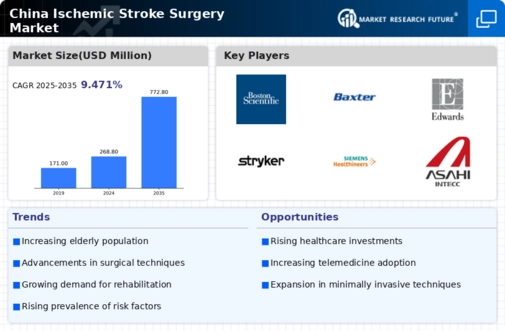Rising Healthcare Expenditure
The increase in healthcare expenditure in China is a significant driver for the ischemic stroke-surgery market. As the economy continues to grow, both public and private sectors are allocating more resources to healthcare services. This trend is reflected in the rising per capita healthcare spending, which has seen an increase of approximately 10% annually over the past few years. Such financial commitment allows for the procurement of advanced surgical technologies and the training of healthcare professionals, thereby enhancing the overall quality of care for ischemic stroke patients. Moreover, as patients become more willing to invest in their health, the demand for surgical interventions is expected to rise, further propelling the growth of the ischemic stroke-surgery market. This trend indicates a shift towards prioritizing health and wellness, which is likely to have lasting implications for the industry.
Government Initiatives and Funding
Government initiatives aimed at improving healthcare infrastructure are playing a pivotal role in the ischemic stroke-surgery market. In recent years, the Chinese government has increased funding for healthcare services, particularly in the realm of stroke management. This includes the establishment of specialized stroke centers and the implementation of national stroke prevention programs. Such initiatives are designed to enhance early diagnosis and treatment, thereby reducing the incidence of severe cases that require surgical intervention. The financial support from the government not only facilitates the development of advanced surgical facilities but also encourages research and development in the field. As a result, the ischemic stroke-surgery market is likely to benefit from these strategic investments, leading to improved patient care and outcomes.
Advancements in Surgical Techniques
Innovations in surgical techniques are significantly influencing the ischemic stroke-surgery market. The introduction of minimally invasive procedures, such as endovascular thrombectomy, has transformed the treatment landscape for ischemic stroke patients. These advanced techniques not only reduce recovery times but also improve patient outcomes, making them more appealing to both healthcare providers and patients. In China, the adoption of these technologies is on the rise, with hospitals increasingly investing in state-of-the-art equipment and training for medical personnel. This trend is expected to continue, as the demand for effective and efficient surgical interventions grows. The integration of robotics and artificial intelligence in surgical procedures may further enhance the capabilities of healthcare professionals, potentially leading to better results in the ischemic stroke-surgery market.
Increasing Incidence of Ischemic Stroke
The rising incidence of ischemic stroke in China is a critical driver for the ischemic stroke-surgery market. Recent statistics indicate that ischemic strokes account for approximately 70% of all stroke cases in the country. This alarming trend is attributed to factors such as urbanization, lifestyle changes, and an increase in risk factors like hypertension and diabetes. As the population ages, the number of individuals at risk continues to grow, leading to a higher demand for surgical interventions. The healthcare system is thus compelled to enhance its capabilities to manage this increasing burden, which in turn propels the growth of the ischemic stroke-surgery market. Furthermore, the economic implications of stroke-related disabilities necessitate timely surgical solutions, further emphasizing the importance of this market in addressing public health challenges.
Growing Collaboration Between Public and Private Sectors
The collaboration between public and private sectors is emerging as a vital driver for the ischemic stroke-surgery market. In China, partnerships between government entities and private healthcare providers are becoming increasingly common, aimed at improving stroke care and surgical outcomes. These collaborations often focus on sharing resources, expertise, and technology, which can lead to enhanced service delivery and patient care. For instance, private hospitals may provide advanced surgical techniques and equipment, while public institutions can offer broader access to patients. This synergy not only improves the efficiency of stroke management but also fosters innovation within the ischemic stroke-surgery market. As these partnerships continue to evolve, they are likely to create a more integrated healthcare system, ultimately benefiting patients and healthcare providers alike.


















Leave a Comment